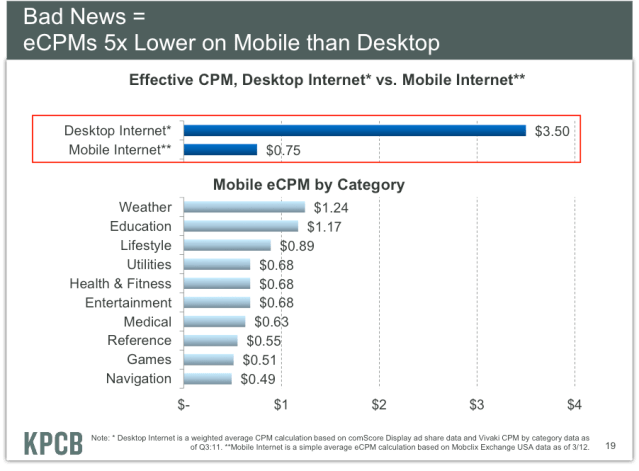Editor’s note: Keith Teare is General Partner at his incubator Archimedes Labs and CEO of recently funded just.me. He was a co-founder of TechCrunch.
As all predatory, or formerly predatory, men and women know, if you’re at a party and still by yourself at 2 a.m., and the drinks have been flowing, bad behavior replaces etiquette as the crowd shrinks. That’s when desperation to not leave alone kicks in.
There is a new law emerging in cyberspace. As desktop traffic growth declines, and mobile adoption explodes, predatory marketers need to monetize mobile traffic or die trying.
As this law takes hold, bad behavior is replacing smart long-term product thinking. The result is an explosion of unnatural acts of engagement. Facebook allows users to escape its filters (designed to give a good experience) by paying to force their Facebook posts in front of their friends — $7 a time and you’re golden. Twitter sends constant reminders about “what you missed” on its service. Google Plus has notification defaults set to a level that results in constant stream of inane emails.
Users are the net losers in this festival of lowering the bar when it comes to how badly behaved a marketer is permitted to be in order to drive use.
Let’s examine this increasingly desperate effort to engage with users.
1. The key driver is that mobile CPMs are only 15 percent of desktop CPMs. As traffic migrates, seven ads on mobile bring the same revenue as one on the desktop, because the lower CPMs coincide with lower click-through rates.
Mary Meeker outlines the gap in this slide, covered by our own Kim-Mai Cutler:
The possibility exists in 2013 that the absolute revenues of the major players will decline as desktop revenues suffer and mobile revenues fail to make up the difference, even as they grow dramatically. This nightmare scenario is key to understanding what is driving bad behavior by marketers and product leaders. Bradley Horowitz recently made some pretty good jokes about Facebook’s bad behavior, but Google is not immune from this disease, although its large revenues from desktop search possibly delay the impact compared to Facebook.
Indeed, Google, due to its high desktop-based revenues, should be more focused on the trend than anybody. It has way more to lose than either Facebook or Twitter. All three companies are clearly more than capable of facing the mobile tsunami from a personnel point of view. But tsunamis have a way of being hard to handle no matter how good you are. And shortcuts tend to turn into nightmares.
2. 2013 will be the year of the Chief Marketing Officer.
The need to monetize mobile traffic will dominate Google, Facebook, Twitter and others in 2013. And the pressure is to do it quickly due to the collapse in the growth of desktop-based traffic. Successful CMOs will avoid the pitfalls of driving unnatural acts of engagement and focus on user-benefits derived from monetization strategies. Google did a great job of this in Web 2.0. Adsense and Adwords were a perfect fit for a search-focused user and were crafted to benefit the user, or at least not detract from a user’s goals. Mobile needs to discover a similar organic form of monetization. This is, of course, hard. Mobile is not search-centric. It has several centers – messaging, communications, news, media capture and sharing, entertainment and games. These are all very different and will require unique and new means of developing relationships between users and advertisers.
3. In the absence of long-term thinking, all streams will eventually turn into marketing-infested flows.
This Christmas I received emails from a variety of service providers who had the primary goal of pulling me into, or back into, their service. There is nothing intrinsically wrong with this. If the email had been on the money, and had drawn me in, I may have even welcomed it. But to a fault these were unnatural seduction attempts. My inbox was rendered unusable by the volume of these solicitations. The worst was sent to an alias I use on Twitter. It wasn’t even in my native tongue, nor a tongue I can read without the help of a translation service. But even those in English were transparent in their inability to really tempt me. Re-marketing is increasing part of these efforts.
I have lost count of how many ads offering me products that I have already purchased have flown past me on various sites and devices recently. Even the ad stream is becoming polluted. Targeting efforts are at the bottom of this trend. But from a user point of view targeting is poor and therefore irritating. The recent attempt by Facebook to alter the Instagram terms and conditions, and privacy policy, was a mistake, and acknowledged, but nonetheless it was driven by these desperate efforts.
4. Destination site thinking replaces platform thinking.
A major symptom of the frenzy to monetize is that previously platform-centric products are reverting to destination-site thinking. Twitter’s adoption of media embedding, Instagram’s decision to pull its content from Twitter, Facebook’s launch of Poke and Google’s failure to add a write API to its G+ platform all display an “own the user” mentality. AdSense and AdWords would never have been invented had Larry and Sergey not understood the value of providing a monetization platform for others to benefit from, even for users not on Google. This is the type of thinking required today but currently all roads point to several varied attempts to re-portalize; that is to say, to own your own traffic and seek to monetize it. This is the old Yahoo view of the world and it clearly represents a limited mindset that will not scale to the huge mobile opportunity. For Twitter in particular, which has a large global opportunity as a platform, this trend represents a shrinking of its real opportunity.
5. Platforms steal ideas rather than partner or acquire.
Twitter implemented URL shortening rather than partnering with bit.ly; Facebook launched Poke rather than seek to integrate with or acquire Snapchat. We will see more of this in 2013. One could argue that Google+ as a whole represents this thinking, the opposite of Google’s prior history as a platform company. This is driven by the same desperation as the other trends. Jason Calacanis has a good post on this topic that you should read if you missed it.
6. Advertising on mobile becomes a process of force feeding users with messages from desperate publishers.
There is a lot of money in mobile. Apple and Samsung make money from handsets. Apple and, to a lesser extent, Google make money from apps. E-commerce players make money. Carriers make money from data plans. Advertising is so far disappointing both in terms of its scale and its growth trajectory, as well as the value of a CPM. This disappointment forces mobile marketers to either innovate in the meaning of advertising on mobile or to systematically force feed both a large volume of ads, as well as attempt to target those ads in such a way that higher CPMs can be achieved. Everybody becoming an advertiser and paying for one’s attention is one way we see this. Limiting the distribution of a post, and then incenting payment for the post to be seen, is the ultimate in bad behavior. It won’t work out well.
7. Intimacy and long-term relationships are a forgotten goal.
The essence of good behavior is to start by helping the user achieve a goal. The essence of a mobile device is that it is intimate. Unlike a screen on the wall, where an ad can be irritating, but understandable; or a screen on your desk where a well placed and content-targeted ad can be even helpful; a mobile ad is almost always an intrusion due to the behavior it interrupts being mostly personal and intimate. Of course this is compounded by the real estate it steals from the small screen. The short-term revenue win from displaying an ad is offset by the long-term relationship damage done between the user and the publisher showing the ad. The sense of being a “target” rather than a person is a growing experience, as our sensibilities are increasingly offended.
8. Users become cynical.
The net impact of desperation-driven bad behavior is that users become cynical of publishers they formerly embraced. Privacy invasions, behavior changes by apps, and other experiences lead to the assumption that we, the users, are nothing more than ad fodder. The sad thing here is that users want their favorite publishers to make money, so that they can fund the app or service in question. But the crude methods of monetization are leading to alienation, not love.
9. Advertisers become cynical.
The real nightmare for the industry here is that advertisers also become cynical. Upsetting users is not high on the list of advertisers’ goals. As users react, advertisers will run in the opposite direction. The already slow growth of mobile advertising will slow even further and the already large gap between the hours spent on mobile and the advertising dollars focused on it will grow further. Nobody wants this, but everybody is fuelling it. It is time to take a deep breath and collectively think about how to have the opposite impact.
10. New apps and services can grow quickly by offering intimacy and control to users.
Intimacy is the currency on mobile. Intimacy is a great thing, of course. Users love the ability to engage with those they like, love, and admire, and even those they hate and detest, in a personal mobile space. Apps that feed or empower this intimacy have prospered. Apps that trample over it have suffered. Success stories include WhatsApp, LINE, KakaoTalk, WeChat, Instagram, Voxer, Tango, Skype and others. Central to intimacy is control. If a user’s outputs can be accidentally leaked to people outside of their control, the user will not be happy. TVs are not intimate and control is ceded to the broadcaster or service provider. Desktops are more intimate and ads had to be organic to succeed. Mobile is 100 percent intimate, and bad behavior – and I include targeting here – will fail to produce scalable revenues. Doc Searls, in his Vendor Realtionship Management thoughts, has captured much of this thinking. His book “The Intention Economy, When Customers Take Charge” is a must-read book for the class of 2013 CMOs.
11. Mobile revenue can grow, and even exceed desktop CPMs if long-term models based on organic and intimate relationships between users and brands are at the core.
I definitely long for an unpolluted stream that is 100 percent capable of telling me things I want to be told. I also would love a way to tell the advertisers which brands I love, whether it be my favorite airline, movie theater, restaurant, camera vendor or whatever. I would love a way to regulate or control how my favorite vendors interact with me. Throttling them when they send too much or the wrong stuff, killing their ability to reach me when they behave badly, embracing them when they serve me well. Mobile, as an intimate device, is a great area to place the controls needed to realize much of this. And it scales too. Every human being on the planet has intimate tastes and relationships they love. This is true for their relationships to people, brands, products, organizations, and other entities. Two billion smartphones by the end of 2013 and every entity on the planet makes for a very large opportunity to allow users to become the boss, and for brands to enter into adult relationships with the customers who love them. Mobile is the perfect platform for the dream of one-to-one marketing to finally exist.
But today’s desperation-driven bad behavior, full of unnatural acts of engagement, will sadly have the opposite impact.
Time for all of us to reflect.
[Image via]

